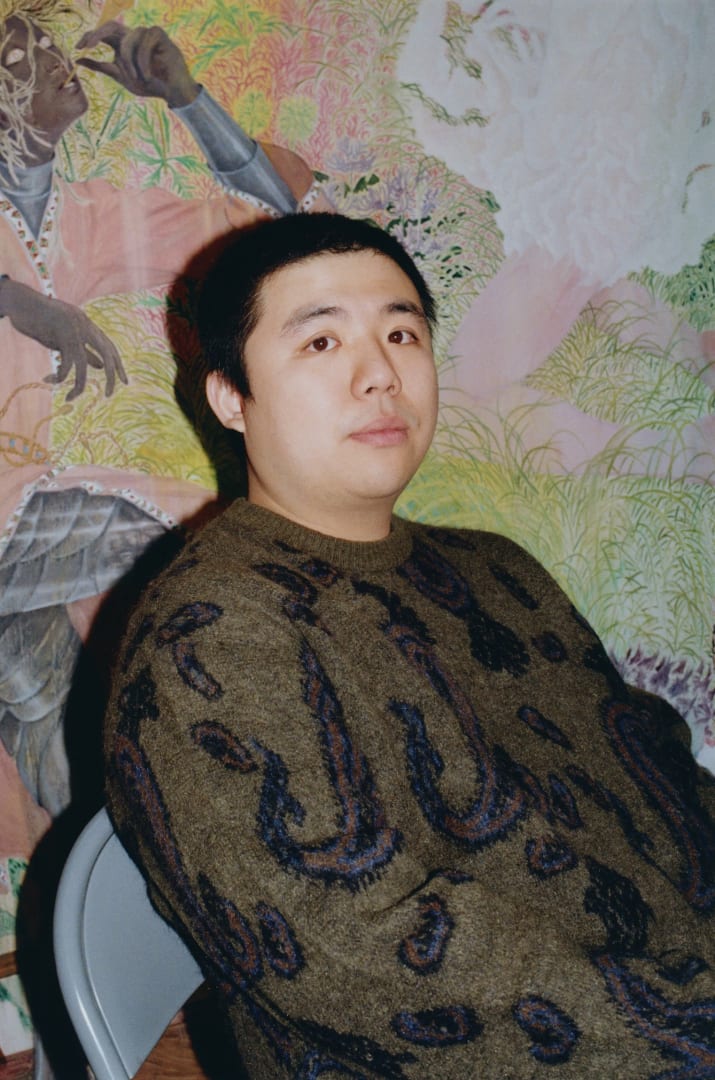The artist responsible for this cross-cultural, decadent mash-up is a soft-spoken, 25-year-old wearing a fluffy paisley sweater. His paintings aren’t straightforwardly allegorical or biographical; they represent scenes from Shilun’s own personal mythology, which alludes to Japanese manga, Western pop culture, and Chinese religious and cultural traditions. There is also a generous dollop of fashion and camp. “I consider camp as the perfect combination of spirit, body, and materials,” Shilun says. Some of the paintings, which will be shown at Bernheim Gallery in London (opening February 7), are inspired by his relationship with the “so-called fortune tellers” who are, by Shilun’s account, ubiquitous in China and dictate much about home life under the aegis of feng shui. It’s a subject personal to Shilun, who was born and brought up in the Cantonese town of Guangzhou. “For a long time in my childhood we weren’t allow to display toy action figures because a grandmaster of feng shui told my mum not to,” he says. “Even Batman had to be put into the closet. You look back and think, ‘That didn’t make any sense at all.’”
The paintings also suggest that Shilun’s subconscious is working overtime. He shows me one called Hunter’s Whistle, which he had intended to be a “simple portrait.” It depicts a figure of indeterminate gender in a corset and headdress decked with flowers and tomatoes, playing the flute. The character has a crossbow at the waist, and on the floor is a human skull in a basket. “It’s peaceful but quite scary—almost like a horror movie,” Shilun says. “I’d describe my practice as a sugar-coated bullet. It looks sweet and delicate but when you come closer, you’re like, what happened here?”
Shilun says that he has vivid dreams, though he never refers to them literally. He has no idea what a work will be until he starts it, often by painting an eye. “It’s like a puzzle game, it comes piece by piece,” he says. “Sometimes I finish a painting and I don’t even know where I started from.” He points out that the drive to create narrative is as old as art, mythology, or religion. “Our ancestors told stories to turn something they didn’t know about into an explainable phenomenon, so I consider myself to be doing the same thing. I can transform indescribable emotions into figures and put them onto canvas.”
Shilun grew up around art. His father is a traditional landscape painter, and his mother ran the local art school, but they never taught him how to paint. He doesn’t discuss his work much with them now. “Every time I ask my dad for his opinion, he says stuff like ‘It’s very beautiful, but the leg is too long.’” Shilun is more interested in drawing upon, then subverting, ancient techniques. “Traditional Chinese paintings use ink applied on rice paper so that you can do really see-through layers, so I’m trying to do the same thing with oil paintings,” he explains. “I use solvent, which can make the pigment really watery. It requires hyper-focus. You can’t wash it off, so it’s quite stressful.” His large canvases take a month or two to finish.

